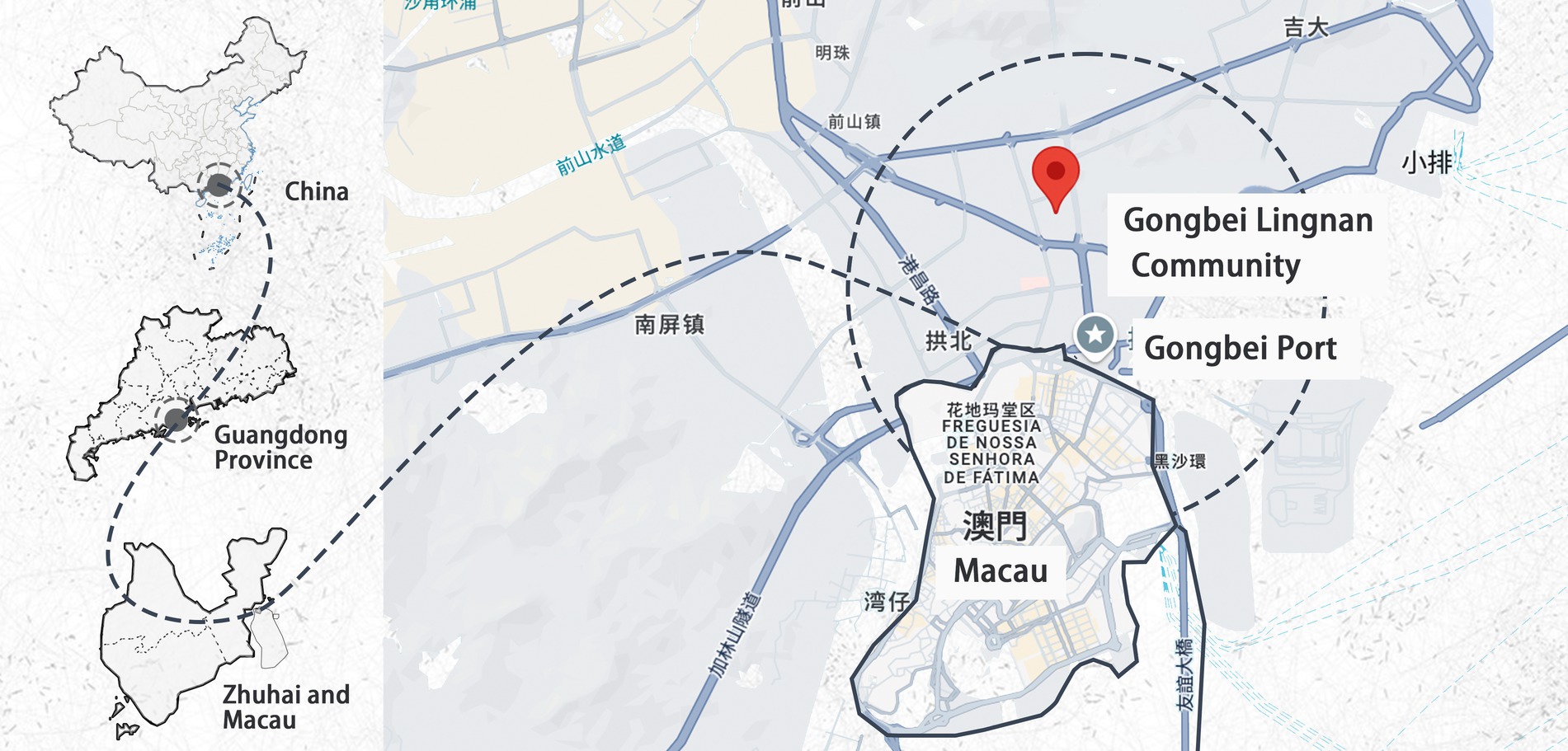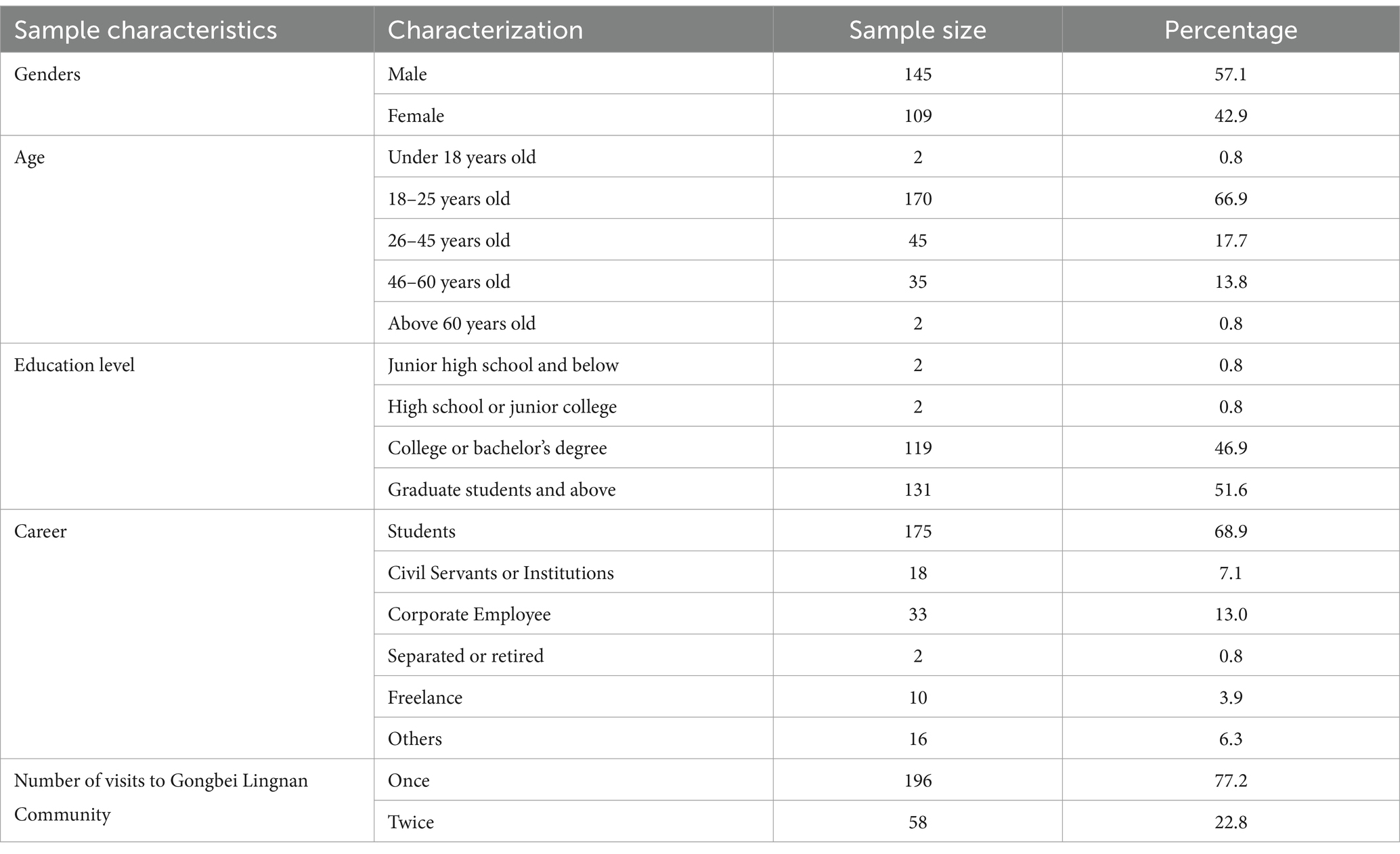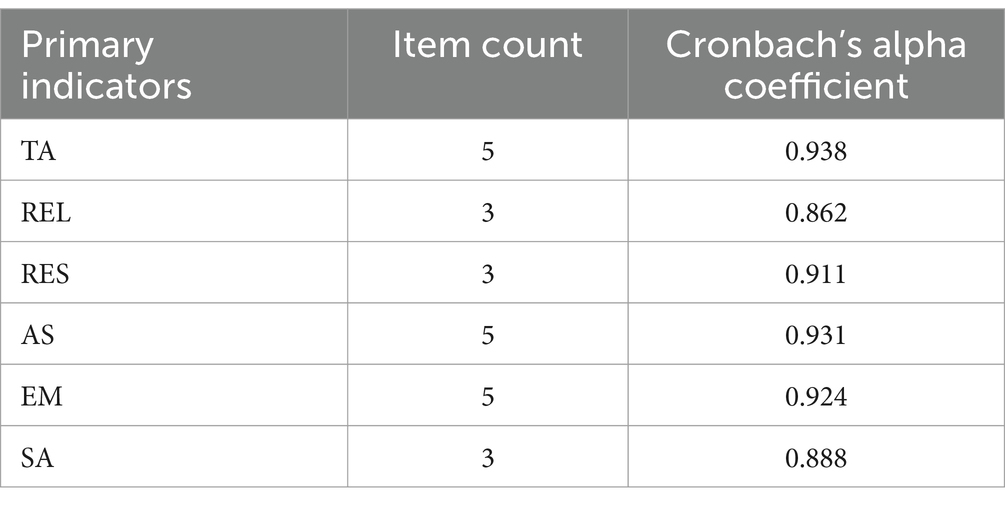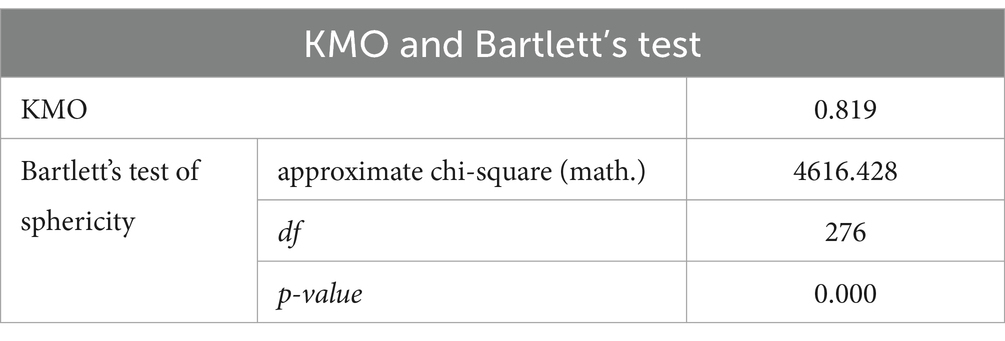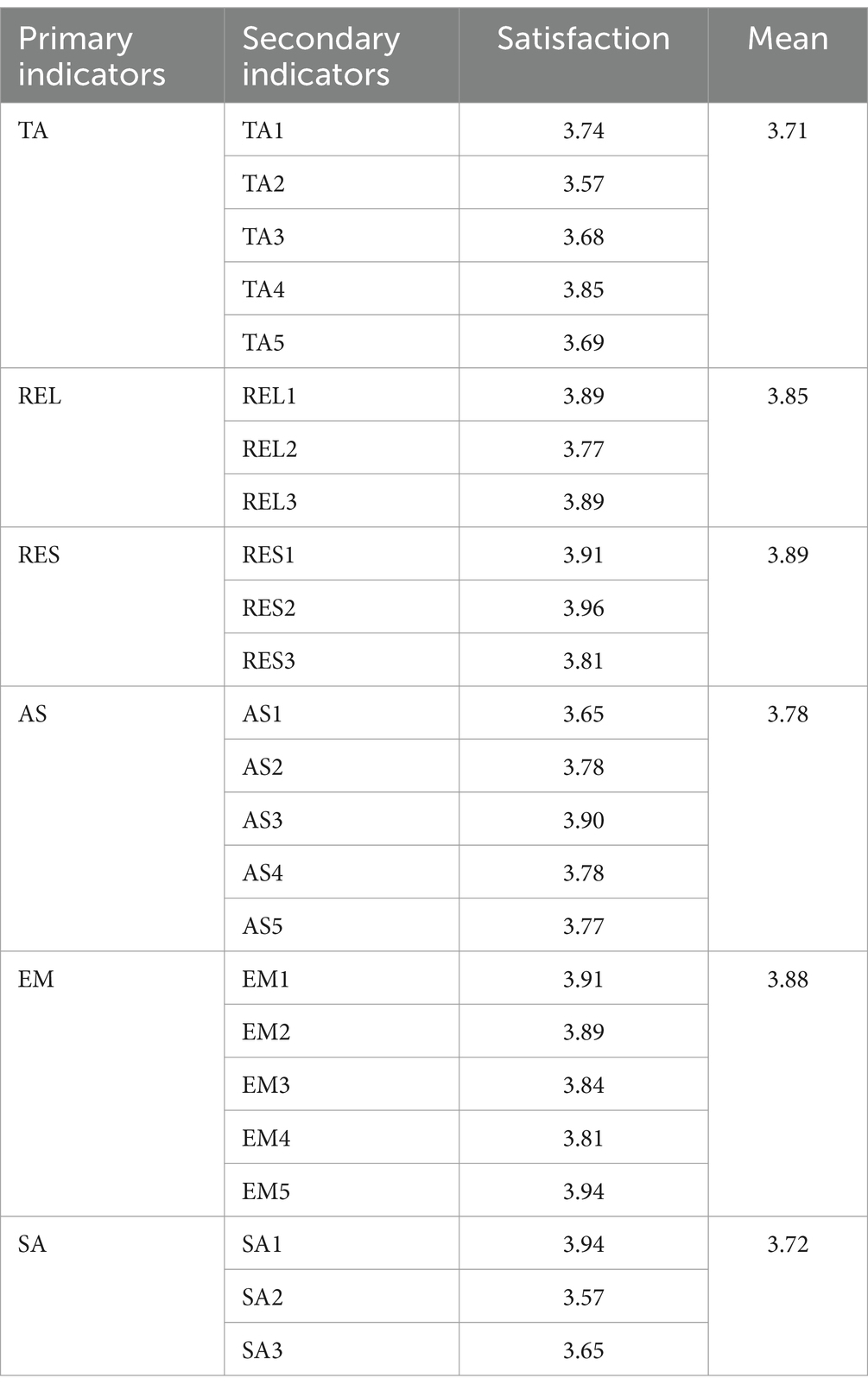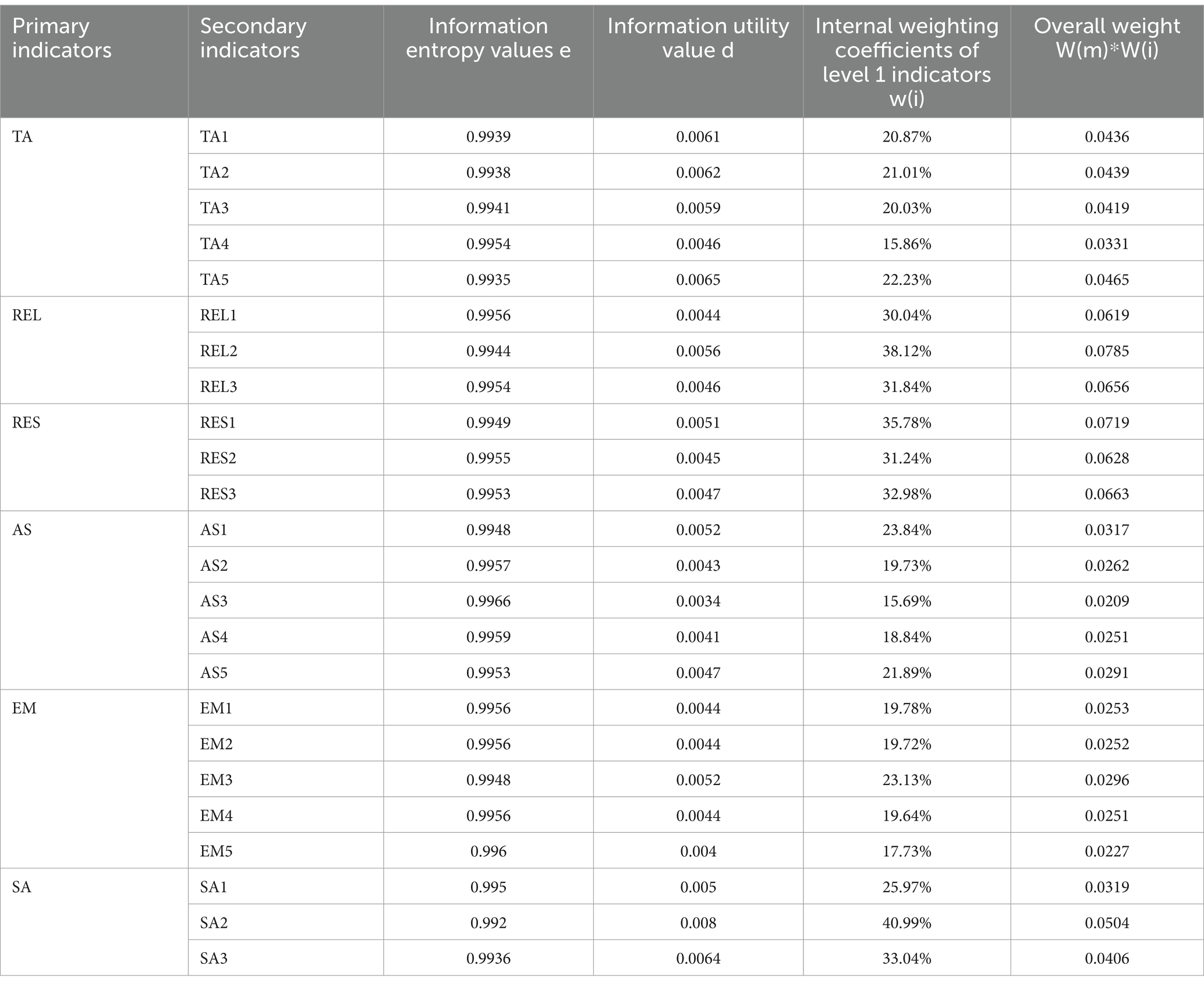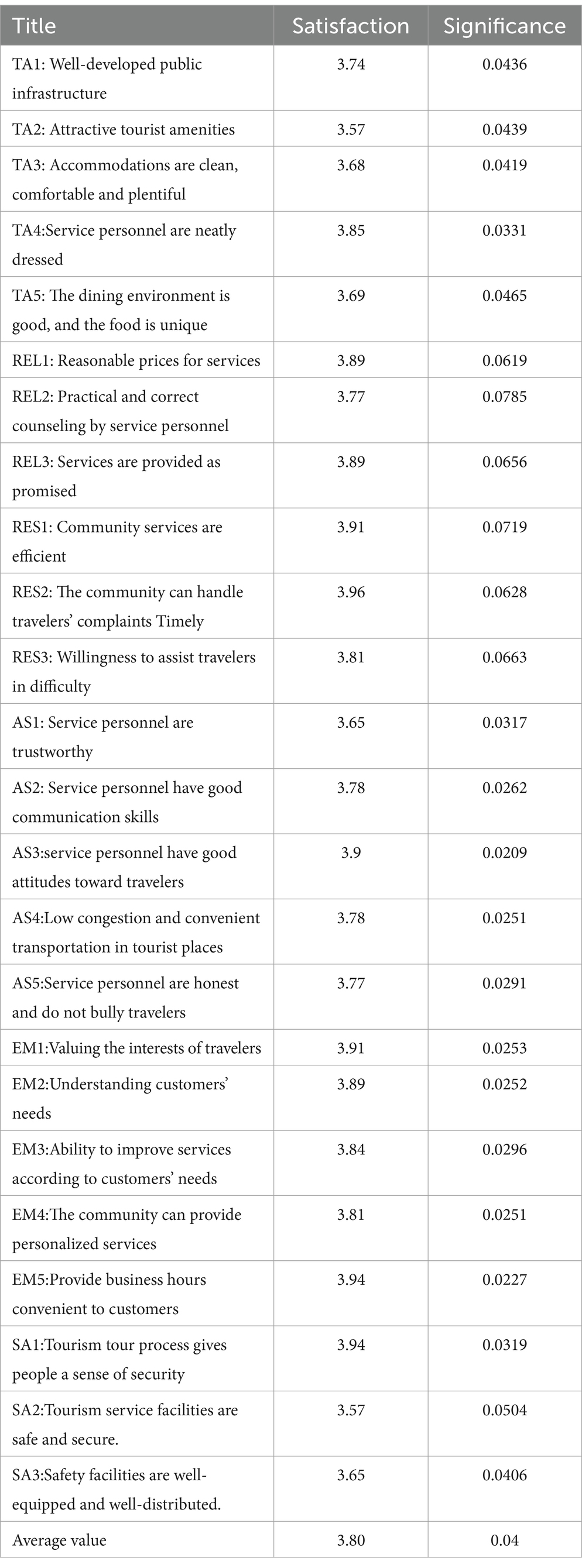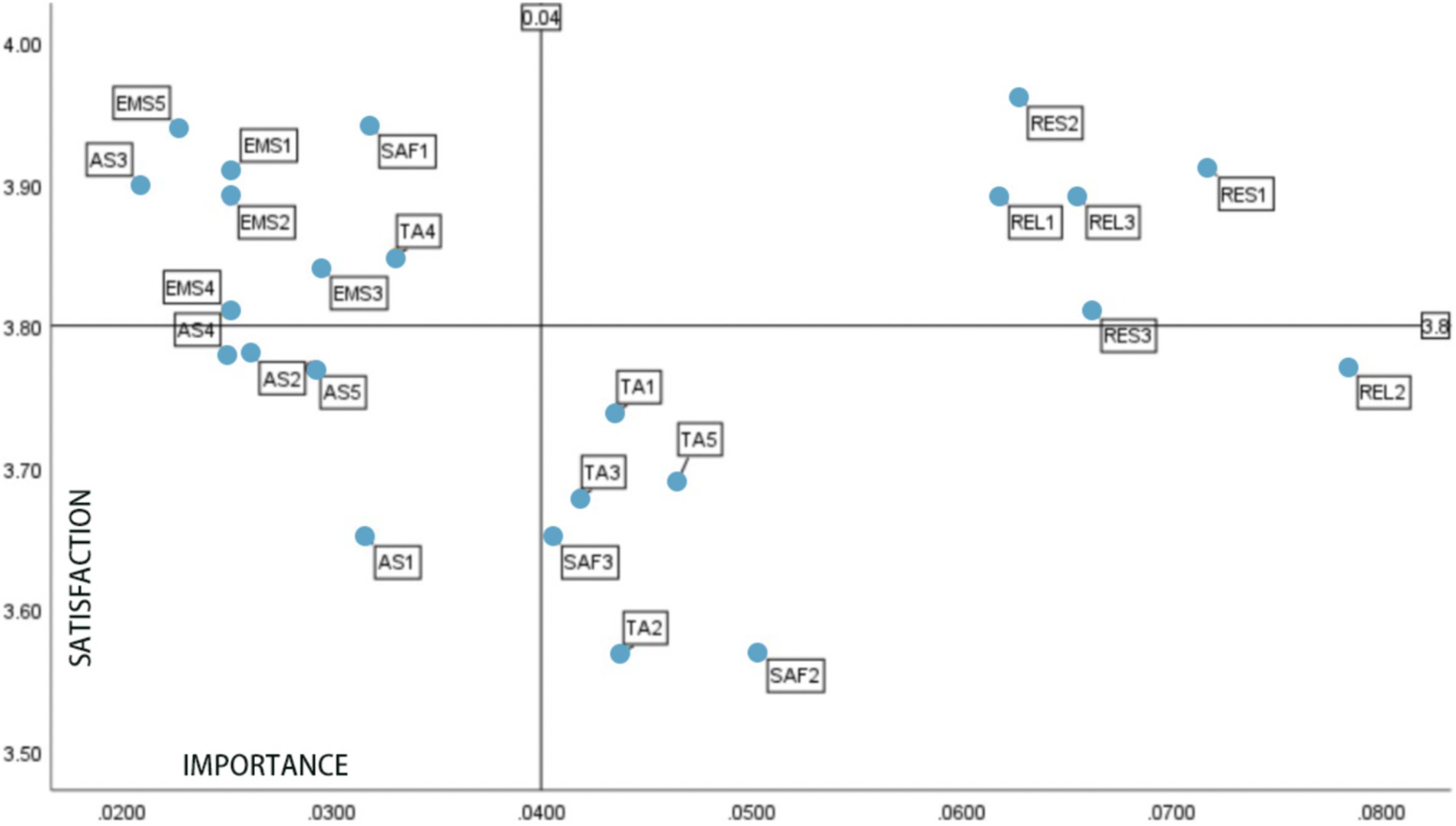- Faculty of Innovation and Design, City University of Macau, Taipa, Macao SAR, China
The Lingnan community, located between Macau and Zhuhai City in China, serves as a connecting port community that attracts a growing number of tourists for leisure and business. The Lingnan community faces the challenge of improving tourism services to meet the ever-increasing needs of tourists with the continuous growth of tourists. Currently, the community’s tourism service facilities are relatively scarce, and the service quality needs to be improved. Hence, improving tourists’ satisfaction with Lingnan tourism services is essential. The SERVQUAL Model is utilized in this research to assess the satisfaction of tourism services in the Lingnan community. The data were collected from 254 tourists who visited the Lingnan community. After passing reliability and validity tests, factor analysis was used to determine the weights of the primary indicators, followed by entropy weight calculations to measure the weights of secondary indicators further, and finally presented as an IPA matrix. The survey results show that the second-level dimension factors under the tangible, reliability, assurance, and security dimensions significantly impact tourist satisfaction. The study shows that tourist satisfaction predominantly affects the sustainable development of community tourism, so the community must focus on ensuring better service quality. Enhancing the attractiveness of Lingnan community tourism is conducive to the joint development of the tourism industry in Zhuhai and Macau but also has essential significance in strengthening the friendship between Zhuhai and Macau.
1 Introduction
The tourism industry has rapidly developed, leading to the introduction of the concept of service design. The tourist industry’s competition has increasingly moved to “user-centered”; the service needs of travelers are highly valued, and enhancing the satisfaction of travelers’ services has become the key to improving the competitiveness of tourism (Ince and Bowen, 2010). Gongbei Port is a vital livelihood channel connecting Macau and the mainland. As of December 29, 2023, the cumulative number of people crossing the border at Gongbei Port in Zhuhai exceeded 100 million, of which mainland residents accounted for nearly 59%, Hong Kong and Macau residents accounted for 40% and more than 13.3 million passengers traveled to and from the port with tourist visas, an increase of more than six times compared to 2022 (Zhang, 2024). Gongbei Lingnan Community is located in the heart of Gongbei, near Gongbei Port, the community has a 76% occupancy rate, and for Zhuhai-Macau frequent traveler houses, carrying to meet the visitors to eat, live, and travel, as well as other functions, is an important window of Zhuhai-Macau tourism (Figure 1). Given the Gongbei Lingnan community’s high visitor traffic, it is necessary to analyze if its service is up to date and capable of meeting the expectations of tourists in order to identify the source of the problem and optimize the service. Therefore, to investigate the weak factors of Gongbei Lingnan community service and improve its service quality, this paper will take the travelers who have experienced the service quality of Gongbei Lingnan community as the research object to carry out further research and help the high-quality development of Zhuhai-Macau region.
2 Literature review
2.1 Quality of tourism services
Since the 1990s, Western economics and tourism scholars have begun conducting relevant research on tourism service quality (Narayan et al., 2008). At the beginning of the 21st century, Chinese scholars have also started to pay attention to this field. Scholars’ definition of tourism quality should include three parts: tourism service quality, tourism experience quality, and tourism product quality (Garrigos-Simon et al., 2019). Many scholars believe that tourism quality mainly refers to the quality of services during tourism, that is, the difference between the customer’s expectations or needs for services and the perceived services received (Drejeris and Rusteika, 2024). When the expected service is equal to the perceived service, the consumer’s perceived service quality is satisfactory; when the expected service is more excellent than the perceived service, the consumer feels dissatisfied, and vice versa, the perceived service quality exceeds the satisfaction level (Salamah et al., 2022). The fundamental theories of psychology, economics, anthropology, sociology, management, and other disciplines are comprehensively utilized in the theoretical study of tourism service quality. The content focuses on six research areas: the definition of tourism service quality, influencing factors, measurement methods, the impact of tourism service quality on tourists, and the motives and paths to improve tourism service quality. The research results are very fruitful (Butnaru and Miller, 2012). However, with the further development of new forms of tourism, more diversified research objects such as community tourism, urban tourism, ecotourism, business tourism, etc., have emerged, and there is a lack of research results in these areas, which can be further explored (Tsang et al., 2015). This paper uses tourism quality-related theories to assess tourism service quality. It conducts further research on improving the quality of community tourism services to enhance the quality of travelers’ tourism.
2.2 SERVQUAL model
Service design emphasizes user-centeredness, and mining user needs is the starting point of service design, which needs to consider all users’ needs throughout the service life cycle (Graham et al., 2019). The perceived quality measurement model is a model to determine service quality by assessing the gap between the actual service level perceived by users and the service level expected by consumers, which can effectively clarify user needs and has been widely used in various service industries (Parasuraman et al., 1988). Gilavand and Maraghi (2019) used the SERVQUAL assessment model to conduct a systematic review and assess the quality of educational services at the University of Medical Sciences in Iran. The study emphasized the importance of identifying service quality gaps to develop an effective quality improvement plan. Faeni (2023) explored patient satisfaction in governmental healthcare services using the SERVQUAL Model, which provided academics and practitioners with guidance on service quality improvement through large-scale data collection of practical support. In addition, Kowalska and Ostręga (2020) applied the SERVQUAL method to assess the quality of traveler services at the Silesian Museum, demonstrating the effectiveness of the modified SERVQUAL method in assessing traveler satisfaction. Based on the low cost, high flexibility, and predictive nature of the SERVQUAL Model, it has been highly recognized for evalutating service quality in various industries and sectors (Pantouvakis et al., 2008).
In tourism applications, different researchers have developed specialized service quality evaluation models based on SERVQUAL, such as LODGSERV, DINESERV, HOLSAT, HISTOQUAL, and ECOSERVQ, which are used for the evaluation of service quality in the hotel industry, catering industry, resort, tourism products, ecotourism, etc. respectively (Xu, 2006). Based on the SERVQUAL Model’s flexibility and tourism services’ characteristics, domestic scholars have also applied and improved the SERVQUAL Model. Chen and Liu (2005) analyzed the characteristics of ecotourism. They compiled the relevant evaluation and blessing dimensions suitable for ecotourism, pointing out that the three most important factors affecting the quality of ecotourism services are accessibility, ecological tangibility, and tangibility. Wang (2005) empirical research on the quality of cruise ship services, in addition to the study of tourism feelings based on the six elements of tourism and attempted to introduce two new variables: safety feelings and value feelings. Summarizing the research results of scholars, the SERVQUAL assessment method is a brief and multi-item assessment method that can provide a more comprehensive and systematic assessment of tourism service quality while having a certain degree of reliability and validity. Since the evaluation method is widely applicable, different research objects can be adjusted according to the characteristics of their services and the five dimensions of their composition and then assessed.
This paper takes Gongbei Lingnan community tourism service quality as the research object and expands the latitude of “safety” according to urban community tourism service characteristics. The latitude of safety has been verified in island tourism, but it is less used in community tourism services. Therefore, the following six latitudes are constructed to assess community service quality in Gongbei Lingnan (Figure 2), and the meaning of each latitude in this study is as follows: (1) Tangibility. Indicates the configuration of physical facilities, equipment, and service personnel in a specific environment that belongs to the service’s physical part. Combined with the research of Dou (2024) and Liu (2011), it mainly includes public infrastructure, such as the degree of perfection and modernization (Sadiq et al., 2020), tourism supporting facilities (attractiveness and degree of perfection, matching of service facilities and services provided), accommodation environment (cleanness and comfort, sufficient quantity), service personnel clothing (neatness of clothing, coordination of clothing worn by the service personnel with the local environment and accessible for travelers to Identification), dining environment and taste (more or fewer types of restaurants, unique cuisine) and other elements. (2) Reliability. Indicates the ability to fulfill service commitments reliably and accurately. Combined with the research of Wang (2007), the reliability of community tourism services is reflected explicitly in the reasonable price of services; the service staff will not ignore the requirements of travelers, the service staff will provide practical and correct counseling, and to provide the promised services. (3) Responsiveness. Community service is efficient and reflected in the willingness to help customers and provide timely service. Whether it can deal with travelers’ complaints promptly and whether there is a willingness to assist travelers with difficulties is an essential indicator for measuring its responsiveness. (4) Assurance. Indicates employees’ intellectual courtesy and ability to convey trust and confidence. Xie et al. (2011) showed that assurances mainly include factors such as the service staff is trustworthy, the service staff’s ability to communicate and express themselves, the attitudes of community residents and service staff toward travelers, the degree of congestion and accessibility of tourist destinations, and the honesty of the service staff in not deceiving customers. (5) Empathy. It is expressed as caring about customer needs and providing attentive and personalized attention to different customers. Liu (2011) emphasized that whether the staff pays attention to the interests of customers, understands the needs of customers, can improve their services according to the needs of customers, whether the community can provide personalized service methods for special populations (such as older people and children), and provide business hours convenient for customers, etc., also affects to a greater extent the user’s evaluation of the quality of community tourism services. (6) Safety. Performance of tourism destinations in general so that people do not have a sense of danger, security risks, and doubts. According to the research of Qolipour et al. (2018), whether the tourism tour gives people a sense of security, whether the tourism service facilities are safe and secure, and whether the safety and rescue facilities are complete and reasonably distributed are essential to measuring safety.
3 Research method
3.1 Research ideas and methods
This study takes travelers who have experienced tourism services in the Lingnan Community in Gongbei as the survey object. Based on the SERVQUAL theoretical Model, the scale was modified by expanding the dimension of “security,” and the questionnaire was used as the primary method to collect the research data. Factor analysis and entropy weighting were used to calculate the weights of the dimensions, and the data results were presented in the IPA matrix (Chen et al., 2024). This paper adopted a questionnaire distribution strategy combining a physical setting with an online platform (Schillewaert and Meulemeester, 2005). The implementation of this strategy included the direct distribution of paper questionnaires to travelers in the community and the use of QR code technology to allow travelers to scan the code to complete the questionnaires online conveniently. This strategy effectively expanded the coverage of the study and ensured the convenient participation of a wide range of travelers, thus enhancing the comprehensiveness and authenticity of the questionnaire results.
3.2 Questionnaire design
Based on SERVQUAL’s original scale, the characteristics of urban community tourism services and the factors influencing service quality were identified through the literature. Then, the scale was amended, thus designing the service perception scale (Table 1). A five-point Likert scale method was used for the questionnaire design, with 1–5 indicating disagree entirely, disagree, generally, agree, and strongly agree, respectively (De Winter and Dodou, 2010). After analyzing the reliability of the questionnaire pre-study data through SPSS software, the questions were corrected and deleted to make the questionnaire topic setting more reasonable.
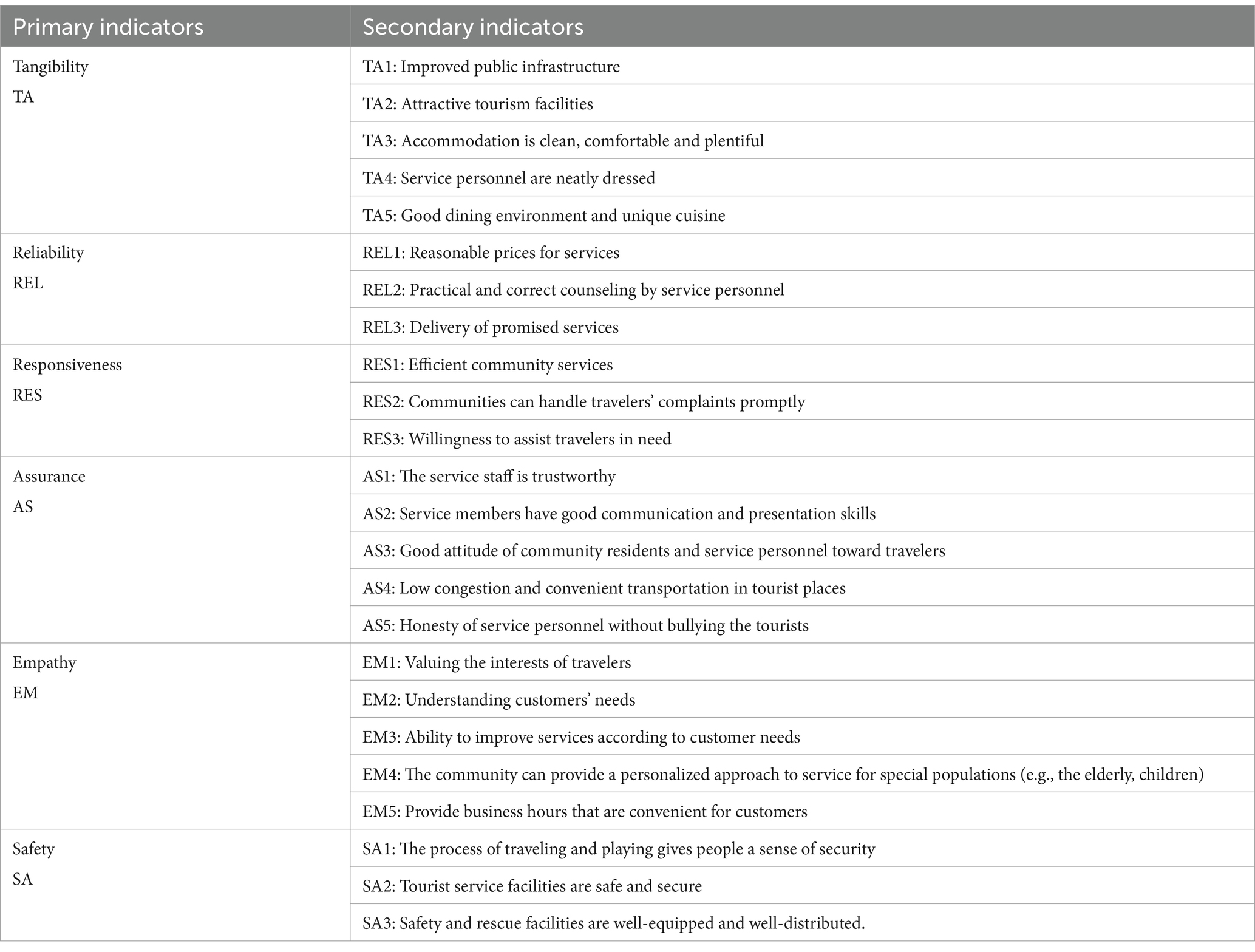
Table 1. Tourism Service Quality Scale of Gongbei Lingnan community based on SERVQUAL model modification two.
3.3 Descriptive statistics
By finely screening the recovered questionnaires, this paper excluded 22 invalid questionnaires due to logical errors or incomplete filling. Finally, it confirmed 254 valid questionnaires, with an effective response rate of 92%. This survey was conducted by summarizing and statistically analyzing the basic information of the surveyed travelers, using the frequency analysis method to analyze the background information of the samples, calculating the frequency and percentage of each option, and summarizing the information of the survey sample data by the distribution of gender, age, education, occupation, and number of times of touring the Gongbei Lingnan Community, and summarizing the statistical results into a Table 2.
3.4 Reliability analysis
Reliability tests measure the level of agreement between the situation reflected in the survey and the actual feelings or facts of the respondents. Among the many means of reliability testing, Cronbach’s alpha (Cronbach’s coefficient) is extremely popular in social science research, and the alpha value’s magnitude directly reflects the scale’s reliability quality (Tavakol and Dennick, 2011). Table 3 shows that the reliability coefficient of this study reaches 0.747, which exceeds the conventional standard of 0.7, indicating that the data are highly reliable and have good stability and internal consistency. Meanwhile, Table 4 shows that the reliability coefficients of the dimensional scales exceeded the conventional criterion of 0.7, indicating that the overall data are highly reliable with good stability and internal consistency.
Validity refers to the effectiveness of the observed variables in accurately measuring the degree of latent variables (Kimberlin and Winterstein, 2008). In this paper, the survey data were analyzed using KMO statistics and Bartlett spherical p-value, and the validity test results were obtained, as shown in summary (Table 5). The KMO value is 0.819, which is far more than 0.7, and the p-value corresponding to the Bartlett spherical test is less than 0.001, which presents significance and indicates that the research data are suitable for extracting information and conforms to the conditions of the factor analysis, and in summary, this survey questionnaire passed the validity test.
4 Results
4.1 Service quality satisfaction analysis
From the statistical analysis in Table 6, it can be seen that travelers’ satisfaction with the tangible aspect is more balanced; travelers’ evaluation of the reliability of the service is higher; travelers highly recognize responsiveness; travelers’ evaluation of satisfaction with assurance is slightly dispersed, and satisfaction is relatively low in terms of the honesty of the service personnel without bullying and the degree of congestion and transportation convenience at the tourist site; travelers are better satisfied in the dimension of empathy; Satisfaction is relatively low in the security dimension, which needs particular attention or improvement.
4.2 Primary indicators weights
In determining the weights of the first-level indicators, this paper adopts the factor analysis method, which aims to categorize multiple potentially relevant variables into the same factor so as to extract the characteristics shared by these variables, and is mainly divided into four steps: correlation analysis of the original variables, extraction of the factors, naming of the factors, and summarization of the analysis (Iacobucci et al., 2022). In this way, we can use a few representative factors to reflect most of the information in the original dataset. When performing factor analysis in SPSS software, this paper set six principal components and obtained a post-rotation cumulative variance explained ratio of 80.432% for these factors, indicating that the factor results are acceptable. In this paper, the factors corresponding to each level of indicators were determined based on the rotated factor loading coefficients. This step not only confirms the correspondence between each level 1 indicator and factor but also further verifies the accuracy and rationality of the original division of level 2 indicators. Finally, this paper normalized the variance explained ratio obtained to get the weight of each level 1 indicator (Table 7).
4.3 Secondary weighting indicators
To measure the importance of each secondary indicator more precisely, this paper introduces the entropy weight method to calculate these weights. Entropy is a metric that is mainly feedback on the degree of disorder in a system; the lower the value means that its uncertainty is low, the more practical information it contains, and therefore, the higher the importance in decision-making and, accordingly, its weight will be given a more significant value (Luo et al., 2016). The entropy weight method is based on the concept of entropy, and by using SPSS software, the weight of each secondary evaluation index is calculated to support the analysis (Table 8).
4.4 IPA matrix analysis
IPA analysis method, or importance-satisfaction analysis, is an effective tool for satisfaction analysis (Jin and Park, 2019). The method applies to the analysis of satisfaction with the quality of tourism services, which helps the Gongbei Lingnan community to understand the expectations and actual feelings of travelers about various aspects of community services during tourism and provides data support for improving traveler satisfaction and return rate. The importance and satisfaction data are imported into a two-dimensional coordinate graph to form an IPA matrix. The matrix can be divided into four quadrants: essential and satisfied, important but dissatisfied, unimportant and satisfied, unimportant and dissatisfied (Wyród-Wróbel and Biesok, 2017). In this paper, the importance (secondary indicator weight) score and satisfaction score (satisfaction mean) of each question item of the tourism service quality satisfaction questionnaire, i.e., (0.04, 3.80), are taken as the origin of the coordinates (Table 9), and this importance mean is used as the horizontal axis, and this satisfaction mean is used as the vertical axis, to establish the four quadrants of IPA analysis (Figure 3).
Quadrant 1 (High Importance, High Satisfaction): Items located in this quadrant imply that they are essential to travelers and that travelers have a high level of satisfaction with these aspects. This means that the destination or service is doing an excellent job in these areas and should continue to maintain and seek further optimization. Items such as “services are reasonably priced” and “ability to deal with travelers’ complaints in a timely manner” fall into this quadrant, indicating that these are areas of deep concern to travelers and are currently performing well.
Quadrant 2 (Low Importance, High Satisfaction): Items that fall into this quadrant are relatively less important, although they currently have a high level of satisfaction, which means that these areas, while performing relatively well, are not a significant consideration in a traveler’s choice of destination or a top concern of the traveler. Maintaining the status quo may be a more reasonable strategy for these types of items without over-investing in improvements.
Quadrant 3 (Low Importance, Low Satisfaction): Items in this quadrant are neither essential nor have high levels of traveler satisfaction. These may be areas that can be set aside for the time being or improved incrementally without the need to invest significant resources immediately. Items such as “public infrastructure is modernized” and “service staff is trustworthy” scored low but also low importance, implying that these are not key to improving the overall tourism experience in the short term.
Quadrant 4 (High Importance, Low Satisfaction): Areas that require focused attention and immediate action. These items are essential to travelers, but the current performance is unsatisfactory. Improving performance in these areas will significantly impact improving the overall quality of tourism services. “Safety and security of tourism service facilities” and ‘availability and reasonable distribution of safety and rescue facilities’ fall in this quadrant, suggesting that scenic spots need to strengthen safety measures and upgrade related facilities, as this is directly related to travelers’ basic needs and feelings.
5 Discussion
According to the Importance-Satisfaction IPA analysis, the secondary indicators below responsiveness and empathy are all located in the four quadrants in the dominance and maintenance zones, which can be moderately regulated and maintained for optimization, whereas most of the secondary indicators below the tangible, reliability, assurance, and security dimensions fall into the improvement and vulnerability zones, and it is necessary to put forward targeted recommendations to enhance the Gongbei Lingnan Community Tourism overall service quality.
5.1 Tangibility
With regard to the physical latitude, most of the secondary indicators are concentrated in quadrant 4, suggesting that this dimension requires focused improvement as a whole. Specifically, the quality of community services can be optimized through two dimensions: “stability” and “innovation.”
On the one hand, “stability” primarily refers to meeting the basic needs of travelers and improving the quality and quantity of the community’s public infrastructure, including but not limited to public bathrooms, parks, pharmacies, cultural centers, and various transportation stations (Xu, 2023). Research has identified several prominent infrastructure-related issues in the Lingnan community: narrow roads within the community, resulting in low traffic efficiency; an insufficient number of public parking lots, which negatively impacts tourists’ travel experiences; arbitrary occupation of some public activity spaces, reducing their usability and functionality; and inadequate public green spaces and restrooms, failing to meet the basic needs of tourists. These issues stem from delays in the construction and maintenance of public infrastructure, which directly affect tourists’ overall satisfaction and the quality of community services. It is recommended that the Lingnan community accelerate the construction and renovation of its infrastructure to enhance service quality and community appeal.
On the other hand, “innovation” emphasizes broadening community development ideas to further enhance tourism appeal and cultural value. Studies have shown that cultural contact significantly influences tourists’ memorable experiences, which in turn positively impacts their overall satisfaction with a destination (Khosravi et al., 2024). As an important cultural convergence point, a port-type community contains rich cultural elements and unique customs, which should be fully explored and presented through tangible forms. Firstly, in-depth research into the cultural identifiers of the two regions connected by the port is essential. The distinctive elements of Macao and Lingnan cultures can be combined to create a unique community style. For example, the architectural style could integrate Portuguese tiles and Macao’s retro esthetic with iconic Lingnan cultural elements, such as Manchurian windows and wok-ear houses. These elements can be applied to the design of architectural façades, wayfinding systems, and boutique lodgings, creating a community landscape that is both rich in traditional cultural heritage and visually appealing. Portuguese tiles, for instance, could be used to decorate street walls in the Lingnan community, establishing a cohesive cultural style. Meanwhile, features like Manchurian windows and wok-ear houses could embellish the neighborhood, forming a fragmented yet distinctive cultural scene that highlights the vibrant cultural fusion between the two regions. Secondly, port-type neighborhoods serve as important hubs for showcasing the culinary cultures of the two areas. The Gongbei Lingnan community is renowned for its unique morning tea and night congee traditions, while Macao offers signature dishes such as Portuguese-style cuisine, egg tarts, and pork chop buns. Developing a food street that combines the culinary cultures of both areas would be a compelling way to enhance travelers’ unforgettable experiences (Tsai, 2016). This culture-based design not only deepens travelers’ understanding of the unique traditions of Zhuhai and Macao but also fosters a sense of cultural identity, strengthening the bond between the two regions.
5.2 Reliability
In the reliability dimension, the indicator assessing the ability of service providers to offer practical and accurate advice is located in the fourth quadrant, indicating an urgent need for attention and improvement. First, a potential strategy to enhance the quality of tourism services is to screen and ensure the information quality and professional competence of service providers (Li and Liu, 2012). In this regard, the Lingnan Community can prioritize recruiting permanent residents who frequently travel between Zhuhai and Macao, possess substantial experience, and are proficient in Mandarin, Cantonese, English, Portuguese, and other languages commonly used in these areas. These individuals can serve as traveler counseling personnel in the Lingnan Community of Gongbei, providing accurate and reliable advice to tourists. Secondly, as the demand for information services among tourists has grown significantly, leveraging intelligent tourism systems has become an essential approach to addressing travelers’ personalized needs (Jin, 2012). In light of the trend toward regional tourism integration, port-type communities should establish a real-time, continuously updated tourism information system for Zhuhai and Macao. This system should integrate and share resources, including tourism advisory content, official websites of attractions, and app platforms. On the one hand, such a system allows travelers to independently access real-time, accurate tourism information, enhancing their overall experience. On the other hand, it alleviates the workload of service personnel, thereby improving overall service efficiency and quality.
5.3 Assurance
The issues raised by tourists (e.g., service personnel integrity and trustworthiness, communication skills, congestion, and transportation accessibility of the destination) are located in the third quadrant, referred to as the improvement zone, and can be gradually and moderately addressed in the long term. Service personnel act as a vital communication bridge between destinations and tourists, and their service quality significantly influences tourists’ overall impressions and satisfaction with the destination. Consequently, they bear a great responsibility in shaping the destination’s image (Ap and Wong, 2001). In training service personnel, the community should establish a service feedback platform to gather travelers’ opinions and conduct regular staff training. Training efforts should focus on two key areas: improving the quality of personnel and enhancing their technical skills. To enhance personnel quality, training programs should prioritize attributes such as patience, friendliness, and responsibility to ensure travelers receive high-quality tourism consulting services. To improve technical skills, training should emphasize effective communication, enabling staff to clearly convey information and accurately address travelers’ inquiries, ensuring that consultation content is error-free. Additionally, given the unique geographical and cultural conditions of the Zhuhai-Macao region—characterized by the integration of Eastern and Western cultures—service personnel must adopt an international perspective. They should be proficient in languages such as Mandarin, Cantonese, and English and effectively use technological tools to facilitate smooth communication. Positive impressions created by service personnel can have a lasting impact, contributing to the value and reputation of the Zhuhai-Macao tourism area while enhancing tourists’ satisfaction.
Regarding tourist traffic, easing congestion in tourist areas requires collaboration between the community and government to implement effective traffic planning and management measures. Optimizing the road network is essential to ensuring smooth and efficient traffic flow. For instance, in the Gongbei Lingnan community, multiple diversion centers could be established alongside a guiding signage system to direct tourists toward nearby bus stops or parking lots, thereby preventing congestion caused by concentrated tourist flows and maintaining traffic order. Furthermore, studies have shown that transportation accessibility positively correlates with tourism development levels (Wang and Chen, 2011). As a critical node connecting Zhuhai and Macao, improving the accessibility of Lingnan Community is crucial for fostering tourism economic growth and increasing the attractiveness of the Zhuhai-Macao region. This involves enhancing connectivity between Lingnan Community and other internal urban nodes and improving transportation accessibility between cities on both sides of the port to strengthen the overall transportation system. For example, the Lingnan Community in Gongbei could introduce shuttle bus services and establish direct bus routes connecting major Zhuhai attractions (such as Yuanming New Garden and Seaside Park) to Gongbei Port, thereby reducing tourists’ time spent on transfers. Additionally, a dynamic scheduling model could be implemented to increase the number of high-frequency shuttle buses during peak tourist periods, alleviating congestion effectively. These measures not only improve transportation convenience between Zhuhai and Macao but also help reduce congestion during peak tourist seasons, ultimately providing travelers with a more enjoyable and seamless travel experience.
5.4 Safety
Safety is the lifeline of tourism, and comprehensive tourism safety measures are essential for improving the competitiveness of tourism destinations and ensuring the sustainable development of tourism (Ma et al., 2020). In terms of traditional tourism safety factors, communities must prioritize the inspection and maintenance of hardware facilities to eliminate potential safety hazards. On the one hand, tourism service facilities (e.g., hotels, elevators, sightseeing equipment) require regular and thorough safety inspections. For instance, the electrical wiring in hotels within Lingnan communities should be inspected regularly to prevent fire risks. On the other hand, Lingnan communities should ensure the availability of necessary safety equipment. Standard fire-fighting tools (e.g., fire extinguishers, smoke alarms), clearly marked emergency exit instructions, and accessible first-aid kits should be installed in public areas. For example, automated external defibrillators (AEDs) could be placed on the densely populated central streets of the Lingnan Community in Gongbei to provide emergency assistance for sudden cardiac incidents among tourists. These measures not only enhance the community’s ability to respond effectively to emergencies but also improve its safety image, fostering greater trust among tourists.
As tourism develops, non-traditional safety factors are also becoming critical in shaping tourism activities in port-connected regions (Wang et al., 2012). Port-type communities, therefore, need to act as transitional zones, offering travelers legal, cultural, and environmental security. First, raising awareness of local laws, regulations, and customs is essential. The two areas connected by the Lingnan Community often differ in their legal systems, cultural backgrounds, and religious practices. Tourists may lack sufficient understanding of these differences, potentially leading to violations of local taboos or regulations and resulting in safety issues. For example, Macau has strict non-smoking regulations in public places, and many tourists have faced fines due to a lack of awareness. To address this, Lingnan communities could provide multilingual tourist information through display screens or brochures, covering local legal restrictions, cultural taboos, and religious etiquette. Such initiatives would not only help tourists avoid potential legal or cultural conflicts but also promote mutual understanding and respect for the cultures of both regions. Second, responding to natural environmental safety is equally important. The Zhuhai-Macao region’s subtropical climate makes it susceptible to frequent typhoons and floods, which may result in sudden tourism safety incidents. To mitigate these risks, port-type communities should enhance their early warning and emergency response mechanisms. For instance, early warning information should be disseminated in areas prone to natural disasters or accidents, allowing for timely precautions and minimizing risks to life and property.
6 Conclusion
As the land port with the most significant passenger clearance volume in China, Gongbei Port is vital in promoting people-to-people exchanges between the Mainland and Macau. Taking the Gongbei Lingnan Community as an experimental point spreading to the surface, the gradually upgraded Gongbei Port makes the connection between Zhuhai and Macau closer. It promotes the cooperation between Zhuhai and Macau to move forward. Carrying out the Gongbei Lingnan Community Tourism Service Quality Assessment provides a strategic perspective for optimizing urban community tourism, further improves the existing service model, and is necessary to promote the continuous progress of Zhuhai-Macau urban tourism and improve its comprehensive competitiveness. This paper applies the service design quality evaluation theory to assess the service quality of the Gongbei Lingnan community, which makes the evaluation logic more transparent and the process more explicit, and begins to unfold the research related to port-type community, tourism service quality, SERVQUAL theoretical Model, etc., and constructs an evaluation of 6 first-level indexes and 24 s-level indexes of tangibles, reliability, responsiveness, assurance, empathy and safety The results of the research are reflected in (1) Expanding the dimension of safety based on SERVQUAL’s related research on community services, and providing a basis for quantitative assessment of community tourism service quality in the future through the SPSS reliability and validity test. (2) Combining factor analysis and entropy weighting method, the weighting ratio is calculated for each dimension of the evaluation system of community tourism service quality, exploring the current problems of community service and proposing optimization strategies, which is of great value to the improvement of community service level in Gongbei Lingnan. Due to the limitation of research resources, this paper also has some limitations and will be deepened in the following aspects in the subsequent research. On the one hand, from the research object, based on the traveler group to supplement the survey for the local community, merchants and other relevant stakeholders, and according to the population classification to expand the research sample, to obtain a more comprehensive evaluation of the quality of community tourism. On the other hand, from the data source, the number of questionnaires in the online survey accounted for a large proportion. Hence, there is a certain degree of one-sidedness; in the future, research should be combined with the interview method for travelers to conduct more in-depth research to obtain more comprehensive data. This study relies on the location of Gongbei Port as the characteristics of the urban community service quality improvement and transformation strategies to give the data support, enriching the service quality evaluation theory applied to the community tourism research results. However, the characteristics and positioning of each port are different, but in the process of development of the formation of new ideas and new methods can be a reference for other port-type communities.
Data availability statement
The original contributions presented in the study are included in the article/supplementary material, further inquiries can be directed to the corresponding author.
Ethics statement
Ethical review and approval was not required for the study on human participants in accordance with the local legislation and institutional requirements. Written informed consent from the [patients/participants OR patients/participants legal guardian/next of kin] was not required to participate in this study in accordance with the national legislation and the institutional requirements.
Author contributions
JL: Methodology, Writing – review & editing. XK: Investigation, Writing – original draft. PW: Conceptualization, Writing – review & editing.
Funding
The author(s) declare that financial support was received for the research, authorship, and/or publication of this article. This research was supported by “the National Art Foundation Artistic Talent Training Program of China” (2024-A-05-110-622) and “Macao Special Administrative Region Science and Technology Development Fund” (0036/2022/A).
Conflict of interest
The authors declare that the research was conducted in the absence of any commercial or financial relationships that could be construed as a potential conflict of interest.
Generative AI statement
The authors declare that no Gen AI was used in the creation of this manuscript.
Publisher’s note
All claims expressed in this article are solely those of the authors and do not necessarily represent those of their affiliated organizations, or those of the publisher, the editors and the reviewers. Any product that may be evaluated in this article, or claim that may be made by its manufacturer, is not guaranteed or endorsed by the publisher.
References
Ap, J., and Wong, K. K. (2001). Case study on tour guiding: professionalism, issues and problems. Tour. Manag. 22, 551–563. doi: 10.1016/S0261-5177(01)00013-9
Butnaru, G. I., and Miller, A. (2012). Conceptual approaches on quality and theory of tourism services. Procedia Econ. Finance 3, 375–380. doi: 10.1016/S2212-5671(12)00167-0
Chen, J., and Liu, F. (2005). Using SERVOUAL service quantity to keep the tour area sustainable development. Ecol. Econ. 11, 94–97.
Chen, J., Pan, L., Zhou, R., and Jiang, Q. (2024). Shaping and optimizing the image of Virtual City spokespersons based on factor analysis and entropy weight methodology: a cross-sectional study from China. Systems 12:44. doi: 10.3390/systems12020044
De Winter, J. C., and Dodou, D. (2010). Five-point Likert items: t test versus Mann-Whitney-Wilcoxon. Pract. Assess. Res. Eval. 15, 1–12.
Dou, Z. (2024). Evaluation of tourism service quality of Shenhou ancient town based on AHP-SERVQUAL mode. J. Xuchang Univ. 1, 132–137.
Drejeris, R., and Rusteika, M. (2024). Assessment of factors determining consumer satisfaction with crop insurance services. J. Infrastruct. Policy Dev. 8:4697. doi: 10.24294/jipd.v8i6.4697
Faeni, D. P. (2023). SERVQUAL measures: Indonesian government healthcare (BPJS) from a human resource perspective. J. Infrastruct. Policy Dev. 8:2271. doi: 10.24294/jipd.v8i2.2271
Garrigos-Simon, F. J., Narangajavana-Kaosiri, Y., and Narangajavana, Y. (2019). Quality in tourism literature: a bibliometric review. Sustain. For. 11:3859. doi: 10.3390/su11143859
Gilavand, A., and Maraghi, E. (2019). Assessing the quality of educational services of Iranian universities of medical sciences based on the SERVQUAL evaluation model: a systematic review and meta-analysis. Iranian J. Med. Sci. 44, 273–284. doi: 10.30476/IJMS.2019.44946
Graham, A. K., Wildes, J. E., and Reddy, M. (2019). User-centred design for technology-enabled services for eating disorders. Int. J. Eat. Disord. 52, 1095–1107. doi: 10.1002/eat.23130
Iacobucci, D., Ruvio, A., and Román, S. (2022). How many factors in factor analysis? New insights about parallel analysis with confidence intervals. J. Bus. 139, 1026–1043. doi: 10.1016/j.jbusres.2021.09.015
Ince, T., and Bowen, D. (2010). Consumer satisfaction and services: insights from dive tourism. Serv. Ind. J. 31, 1769–1792. doi: 10.1080/02642069.2010.496480
Jin, W. (2012). Smart tourism and the construction of tourism public service system. J. Tourism 2, 5–6.
Jin, Y., and Park, Y. (2019). An integrated approach to determining rural tourist satisfaction factors using the IPA and conjoint analysis. Int. J. Environ. Res. Public Health 16:3848. doi: 10.3390/ijerph16203848
Khosravi, A., Esmaeili, S., Fathi, M. R., and Hoseini Amiri, S. M. (2024). The role of soft and hard organizational infrastructures in the quality of event tourism and the consequences of the tourist experience (case study of Mahallat flower and plant festival). Urban Tourism. doi: 10.22059/JUT.2024.334797.988
Kimberlin, C. L., and Winterstein, A. G. (2008). Validity and reliability of measurement instruments used in research. Am. J. Health Syst. Pharm. 65, 2276–2284. doi: 10.2146/ajhp070364
Kowalska, N., and Ostręga, A. (2020). I am using SERVQUAL method to assess tourist service quality by the example of the Silesian museum established in the post-mining area. Land 9:333. doi: 10.3390/land9090333
Li, W., and Liu, F. (2012). Exploring the information quality of tourism information service personnel in the era – based on the analysis of tourism information Service for Tourists. Enterprise Econ. 2, 81–84. doi: 10.13529/j.cnki.enterprise.economy.2012.02.042
Liu, T. (2011). Study on service quality enhancing of rural tourism based on SERVQUAL mode. Resource Dev. Market 6, 569–571.
Luo, H., He, Y., and Li, G. (2016). Slope stability analysis of open pit mine based on AHP and entropy weight method. Int. J. Security Its Appl. 10, 283–294. doi: 10.14257/ijsia.2016.10.3.25
Ma, H., Chiu, Y. H., Tian, X., Zhang, J., and Guo, Q. (2020). Safety or travel: which is more important? The impact of disaster events on tourism. Sustain. For. 12:3038. doi: 10.3390/su12073038
Narayan, B., Rajendran, C., and Sai, L. P. (2008). Scales to measure and benchmark service quality in the tourism industry: a second-order factor approach. BIJ 15, 469–493. doi: 10.1108/14635770810887258
Pantouvakis, A., Chlomoudis, C., and Dimas, A. (2008). Testing the SERVQUAL scale in the passenger port industry: a confirmatory study. Marit. Policy Manag. 35, 449–467. doi: 10.1080/03088830802352095
Parasuraman, A., Zeithaml, V. A., and Berry, L. L. (1988). SERVQUAL: a multiple-item scale measuring consumer perceptions of service quality. J. Retail. 64, 12–40.
Qolipour, M., Torabipour, A., and Faraji Khiavi, F. (2018). Assessing medical tourism services quality using SERVQUAL model: a Patient's perspective. Iran. J. Public Health 47, 103–110
Sadiq, R., Nahiduzzaman, K. M., and Hewage, K. (2020). Infrastructure at the crossroads–beyond sustainability. Front. Sustain. Cities 2:593908. doi: 10.3389/frsc.2020.593908
Salamah, A. A., Hassan, S., and Aljaafreh, A. (2022). Customer retention through service quality and satisfaction: using hybrid SEM-neural network analysis approach. Heliyon 8:e10570. doi: 10.1016/j.heliyon.2022.e10570
Schillewaert, N., and Meulemeester, P. (2005). Comparing response distributions of offline and online. Int. J. Mark. Res. 47, 163–178. doi: 10.1177/147078530504700203
Tavakol, M., and Dennick, R. (2011). Making sense of Cronbach's alpha. Int. J. Med. Educ. 2, 53–55. doi: 10.5116/ijme.4dfb.8dfd
Tsai, C. T. (2016). Memorable tourist experiences and place attachment when consuming local food. Int. J. Tour. Res. 18, 536–548. doi: 10.1002/jtr.2070
Tsang, N. K., Lee, L. Y. S., and Qu, H. (2015). Service quality research on China’s hospitality and tourism industry. Int. J. Contemp. Hosp. Manag. 27, 473–497. doi: 10.1108/IJCHM-01-2014-0048
Wang, N. (2005). Demonstrative research on tourists’ evaluation on the service quality of the Yangtze River three gorges touring cruisers. Tourism Tribune 3, 69–73.
Wang, T. (2007). An analysis of the advantages and disadvantages of service quality assessment methods in the tourism industry. Modern Finance 9, 57–62. doi: 10.19559/j.cnki.12-1387.2007.09.014
Wang, D., and Chen, T. (2011). Spatial analysis for regional difference of tourism economy in China. Sci. Geogr. Sin. 5, 528–536. doi: 10.13249/j.cnki.sgs.2011.05.003
Wang, D., Ming, Q., and Wang, F. (2012). The research of security governance Modeand countermeasures about border Tourismin Yunnan. Tourism Forum 1, 64–69. doi: 10.15962/j.cnki.tourismforum.2012.01.015
Wyród-Wróbel, J., and Biesok, G. (2017). Decision making on various approaches to importance-performance analysis (IPA). European J. Bus. Sci. Technol. 3, 123–131. doi: 10.11118/ejobsat.v3i2.82
Xie, X., Tong, Y., and Chen, P. (2011). Assessment of service quality of country tour operators with SERVQUAL- a case study of Hequan resort. J. Wuhan Polytechnic 5, 114–117.
Xu, S. (2006). The summarization on SERVQUAL and its application on tourism industry overseas. J. Guizhou Minzu Univ. 5, 114–118.
Xu, L. (2023). Analysis of architectural Design in Scenic Spots-Taking the Design of Tourism Supporting Facilities in Xianshan Island, Pingtan as an example. Fujian Architect. Construct. 5, 86–90.
Keywords: community, service quality evaluation, SERVQUAL model, tourist satisfaction, service design
Citation: Liu J, Kuai X and Wang P (2025) Research on the tourism service quality evaluation of Gongbei Lingnan community under the perspective of SERVQUAL theory. Front. Sustain. Cities. 6:1502234. doi: 10.3389/frsc.2024.1502234
Edited by:
Roberto Alonso González-Lezcano, CEU San Pablo University, SpainReviewed by:
Farzad Safaeimanesh, Final International University, CyprusMariam Al-Hammadi, Qatar University, Qatar
Copyright © 2025 Liu, Kuai and Wang. This is an open-access article distributed under the terms of the Creative Commons Attribution License (CC BY). The use, distribution or reproduction in other forums is permitted, provided the original author(s) and the copyright owner(s) are credited and that the original publication in this journal is cited, in accordance with accepted academic practice. No use, distribution or reproduction is permitted which does not comply with these terms.
*Correspondence: Pohsun Wang, cGh3YW5nQGNpdHl1LmVkdS5tbw==
 Jing Liu
Jing Liu Xinru Kuai
Xinru Kuai Pohsun Wang*
Pohsun Wang*